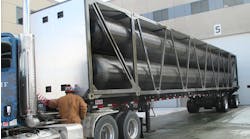ACT Research and FTR Transportation Intelligence reported conflicting numbers for U.S. trailer orders in June, with ACT recording 6,300 units and FTR registering 4,788 units.
But ACT’s tally, June trailer net orders were 19% lower year-over-year and 275 units above May’s intake. ACT’s June order number brings second-quarter net orders to 26,000 units and closes the first half of this year with 74,500 orders placed. That first-half tally was 24% lower than the intake in the first half of 2023, with its faster-paced order environment, lingering pent-up demand, and a still moderately congested supply chain.
“Seasonally adjusted, June’s orders were more than 8,100 units compared to a 7,100 seasonally adjusted rate in May,” Jennifer McNealy, ACT director of CV market research and publications, said in a news release. “On that basis, orders increased 14% month-over-month. Dry van orders contracted 56% y/y, while reefers and flats were significantly higher than their respective tepid net order tallies last June.
“Build outpaced orders again in June, by 15,300 units, with backlogs shrinking more than 14% sequentially. While down considerably m/m, the backlog was significantly lower y/y, down 48% against 2023’s firmer backdrop.
“Despite continual monitoring, little changed in Q2, and despite hopes of the contrary, it was not expected to do so. U.S. trailer manufacturers and suppliers continue to navigate choppy waters, but unlike the past few years, they are on the ebb tide of weaker demand, rather than the flow of congested material supply chains and labor shortages.”
Conversely, FTR’s total of 4,788 units was down 17% m/m but up 44% from a June 2023 order level it says was the lowest since at least 2023. The number of trailers ordered over the last 12 months now totals 199,600 units, according to FTR.
Trailer production decreased by 7% m/m and 29% y/y in June, totaling an output of 20,249 units—21% lower than the average June build level over the past five years, FTR reported.
With net orders coming in substantially below production levels, backlogs in June dropped, falling by 15,526 units to end at slightly more than 113,000 units. The larger m/m decrease in backlogs than in production resulted in a decrease of FTR’s backlog-to-build ratio to 5.6 months. This ratio is the second lowest level since 2020 and is slightly below the historical average prior to 2020. The current ratio indicates little overall incentive for trailer manufacturers to adjust production levels.
“The U.S. trailer market faces significant challenges, primarily due to the stagnant truck freight/rate environment,” said Dan Moyer, FTR senior analyst for commercial vehicles. “Additional near-term potential factors may limit the total trailer market’s growth potential/recovery, including high dealer inventory levels, elevated pricing on inventoried units, and falling used trailer values. The opening of 2025 order books later this year along with the beginning of a potential truck freight recovery may improve market conditions.
“Meanwhile, OEMs will need to manage production cautiously.”











